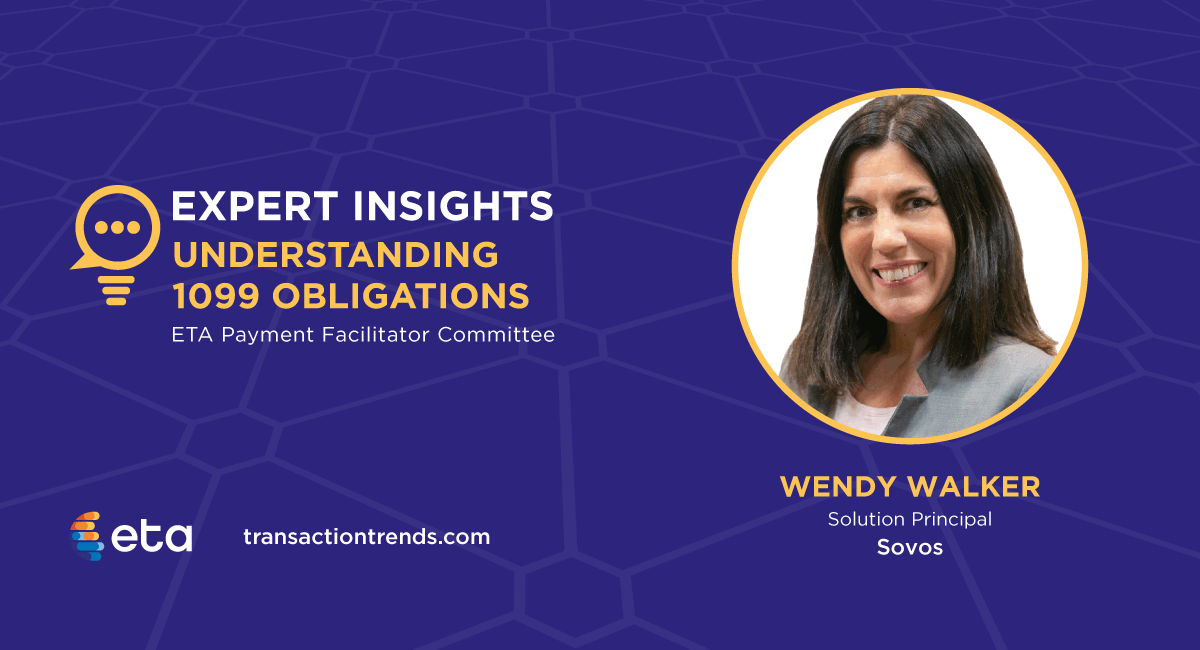ETA Expert Insights: Understanding 1099 Obligations

Wendy Walker, Solution Principal of Tax Information at Sovos
ETA Payment Facilitator Committee
The growth of electronic transactions has expanded opportunities for small businesses and self-employed individuals to receive business payments. To curb gaps in tax compliance associated with electronic commerce, PayFacs are required to report a lot more Forms 1099-K to the IRS and states, starting with 2022 returns filed early next year.
The American Rescue Plan Act of 2021 modified the IRS Form 1099-K reporting threshold from $20,000 in aggregate payments paid over 200 transactions to a payee in the calendar year to $600 in aggregate payments (with no minimum transaction requirement).
To help companies minimize the risks of receiving IRS and state penalties and withholding tax notices associated with erroneous information reported on Forms 1099, the ETA Payment Facilitator Committee held a Q+A with Wendy Walker, Solution Principal of Tax Information Reporting at Sovos.
Following are key takeaways from the conversation.
- Educate the recipients that will be receiving this form. For many of them, it will be the first time they receive a Form 1099-K, and they may contact you if they aren’t sure what to do with it. Create information on your merchant portal to explain the basic 1099-K reporting changes, provide them with downloads of all transactional activity – and most importantly, direct them to their tax preparer for any questions on how to include the income in the annual income tax return process.
- Check the health of your data. The most common penalty for 1099 filers is when the name and taxpayer identification number (TIN) combination reported on the Form 1099-K does not match up to the IRS database. Confirm the validity of your name/TIN combinations by utilizing the IRS TIN matching service – before you file the 2022 1099 information.
- Gross transaction amounts on Form 1099-K may create confusion for merchants. PayFacs must report gross transactions and cannot include adjustments for refunds, voided transactions, fraudulent chargebacks, fees deducted, etc. Be sure to provide merchants with the links to IRS FAQs that discuss these details to avoid disputes over whether the amounts on the Form have been accurately reported.
- Backup withholding is not just an IRS thing. Some 12 states require backup withholding, and most require it when federal backup withholding was also applied to the payment. Make sure you are familiar with IRS and state backup withholding requirements, collect Forms W-9 to help minimize erroneous tax information being collected – and better yet, perform TIN matching before filing 1099’s to verify accuracy.
- Multiple PayFacs – Who Reports? All payment card transactions and all goods and services transactions that meet the $600 threshold are reportable. If a PayFac receives a lump sum representing goods and services payments, the PayFac will receive a Form 1099-K from the payer of that lump sum amount. The PayFac then distributes that income back to merchants – and reports the individual Forms 1099-K for those various payments.

